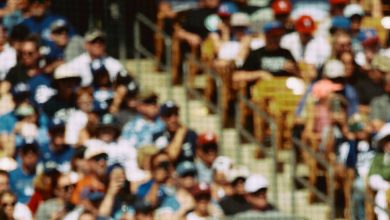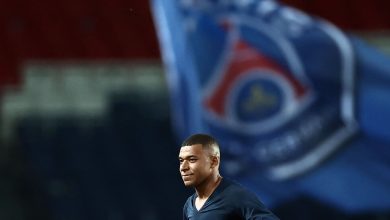Let’s Talk Tennis, and Politics

The Australia Letter is a weekly newsletter from our Australia bureau. Sign up to get it by email.
The drama of the Australian Open began early this year, before the first match, with the saga of whether or not the top men’s player, Novak Djokovic, would be allowed to stay and play despite being unvaccinated.
His deportation was followed by another off-court dispute, when a Melbourne-based artist wore a T-shirt to the tournament that read, “Where is Peng Shuai?”
It was a reference to the Chinese tennis star who, in November, disappeared from public view for weeks after accusing a top Chinese leader of sexual assault. At first, Australian Open security guards told the artist, who’d also brought a sign bearing the slogan, that the items were not permitted, citing a policy that bars fans from making political statements. But then Open organizers relented and agreed to let fans express their concern.
Along the way, of course, there has also been some tennis.
To put all the back-and-forth into perspective, I reached out to Christopher Clarey, a global sportswriter for The New York Times and the author of “The Master: The Long Run and Beautiful Game of Roger Federer.”
He’s in Melbourne covering the action (and writing into the wee hours of the morning). Our conversation has been slightly edited for clarity and space.
We’re not even at the finals yet, but it seems like this is the most disputatious Australian Open in a long time, with Djokovic and the protests on behalf of Peng Shuai. Is that a fair assessment and does it actually feel like that on the ground with players and fans?
I think the Djokovic furor made this the most controversial lead-in to an Australian Open ever, and there have been a few contenders, including reports of widespread match-fixing in tennis in 2016 and last year’s quarantining controversies.
But on the ground, the tournament seemed to move on quickly this year.
When Djokovic boarded that plane on the eve of the Open, it was as if one mini-series was ending and another beginning. I think many Australians had had their fill of the wall-to-wall coverage by then, and though many things have changed in this pandemic, Australians still love their sport. They also have had some excellent national stories to follow, with Nick Kyrgios in singles in the first week and doubles in the second week, and with Ash Barty aiming to become the first Australian in 44 years to win her home singles title.
How has Djokovic’s absence changed the dynamics of competition?
Djokovic is the most successful men’s singles player in the history of the Australian Open with nine titles, including the last three. He is ranked No. 1 and still the leading hardcourt player and came within one match of the Grand Slam record last year before losing the U.S. Open final. So of course his absence has impacted the competitive balance, particularly because he withdrew after the draw was made, which left a power vacuum in the top section of the draw.
Matteo Berrettini of Italy came out of that section to reach the semifinals. But the final four men are all stars or superstars and all ranked in the top eight. Berrettini and Stefanos Tsitsipas have both reached Grand Slam finals. Daniil Medvedev won the U.S. Open last year, and Rafael Nadal is one of the greatest players in the sport’s long history and equal with Djokovic at 20 Grand Slam singles titles. So I think the men’s tournament has retained its legitimacy and interest, even if no one can ever say it was a full-strength event with Djokovic missing.
I’m curious what you make of how the Peng Shuai case has been handled by the tennis world. Do you think Australia’s response fit with the general consensus or diverged?
Like too many things in tennis, the response has been far from unified. Power and governance is fragmented in the sport, with the WTA, ATP, International Tennis Federation and each of the four Grand Slam tournaments making their own moves and decisions. Though all those entities have expressed concern for Peng’s safety, the only one to commit to action is the WTA, the women’s tour, which has suspended its tournaments in China and called for a full Chinese investigation into Peng’s allegations of sexual assault and for an open line of communication with her.
Seen through that prism, Tennis Australia, which runs the Australian Open, is not an outlier. But it does have more at stake with China than the other Grand Slam tournaments. It has a major Chinese sponsor, which has its name on one of the show courts at the Australian Open. Tennis Australia also has offices in China and has promoted Chinese tourism to the tournament. It also wants TV coverage in China, because the time difference with Europe and North America is not ideal for those broadcast windows.
The Australian Open promotes itself as the Grand Slam of the Asia-Pacific, in part because it wants to block the emergence of any potential rivals for its Grand Slam status in the fast-growing region. But Tennis Australia, like the sport, is at something of a crossroads with China. Australia-Chinese relations have deteriorated. Peng’s predicament and the censoring of her allegations in China highlight the nature of the Chinese regime.
For now, unlike the WTA, Tennis Australia is playing a game of wait and see.
Let’s switch back to the game. What’s been your favorite match up to this point?
There have been a few that will stick with me. Matteo Berrettini holding off, just barely, dynamic Spanish 18-year-old Carlos Alcaraz in a fifth-set tiebreaker. Alizé Cornet of France feeling all the emotion of reaching her first Grand Slam quarterfinal on her 63rd attempt with a grueling victory over Simona Halep. Rafael Nadal hanging on at age 35 in the heat to defeat young Canadian Denis Shapovalov, who did not go quietly, accusing chair umpires of being “corrupt” for favoring Nadal and the biggest stars.
But I think the memory-bank match so far has been Medvedev’s five-setter with another young, rising Canadian: Felix Auger-Aliassime. With Djokovic out, Medvedev is the top seed remaining in the men’s event, and FAA, as Auger-Aliassime is nicknamed for obvious reasons, came within one point of knocking him out in the quarterfinals. Medvedev rose up just in time and found his A game with help from a closed roof and a devil-may-care attitude on the biggest points.
This match had so much: long acrobatic rallies, big swings in momentum and huge risks rewarded. Fortune favored the bravest, which is not always the way it turns out, and Medvedev dodged the coming-of-age upset, just barely. He then gave the absent Djokovic some of the credit, saying he channeled him as he came back.
The crowd in Laver Arena did not like that, but you had to like this match, even if it meant writing until 4 a.m. for our deadlines!
Grand Slams of course are big business and pretty tied up national image as well. Do you think the Sturm und Drang this year will affect the Australian Open after the tournament ends?
I do think the tournament has taken a hit. However you feel about Novak Djokovic being unvaccinated, the situation with his visa and deportation got far messier than it should have and reflects a lack of communication between the Australian Open organizers and the government.
The players certainly took note of the confusion: some feel Djokovic became a pawn in an inter-Aussie dispute. So there has been some lost faith on the player side, and in the Grand Slam game, image is a cumulative thing. The Australian Open was once clearly the fourth of the four Grand Slam tournaments in prestige, prize money, facilities and player field (some of the game’s biggest stars routinely skipped the event in the 1970s and 1980s).
The Aussie Open has made quite a comeback and has done so, in part, by making life particularly pleasant for players and their teams. But Australia has been closer to hardship duty for the players of late, with the bush fire smoke during the tournament in 2020, the quarantines of 2021 and L’Affaire Djokovic in 2022.
That all adds up. The tournament is definitely bigger than one star player, even nine-time champion Djokovic, but its future prestige will depend on its continued ability to attract all the stars year in and year out.
Thanks, Chris!
Now here are our stories of the week.
Australia and New Zealand
-
Australian Government Buys Copyright to Indigenous Flag. The flag had been at the center of a dispute, but the move allows anyone to reproduce its design without seeking permission or paying a fee.
-
An Australian aid ship with a coronavirus outbreak docks in Tonga.Twenty-three people aboard the ship have tested positive for the virus, prompting concerns that it could spread to Tonga. The volcano-stricken island has reported only one case during the pandemic.
-
Rafael Nadal Prevails After Five Sets and Charge of Favoritism. Nadal beat Denis Shapovalov to reach the semifinals, then rejected his opponent’s complaints about unfairness, saying, “I think he’s wrong.”
-
How Australia’s Leader Lost Control of His Chinese Social Media Account. A Chinese electronics company said it had bought the WeChat account legitimately, but some Australian officials said it was hijacked, and urged a boycott.
-
Three Tiny Islands Have Borne the Brunt of Tonga’s Tsunami. The sparsely populated islets of Nomuka, Mango and Fonoifua were hit by waves almost 50 feet high, a Red Cross official said.
-
When Rules Aren’t Just Rules. What the Djokovic affair reveals about global border policing.
-
Tongan Man Swept Away by Tsunami Survived After 26 Hours Afloat. Lisala Folau, a retired carpenter, spent a night and day at sea after an undersea volcanic eruption sent waves crashing through his home on the island of Atata.
-
Heard, Felt but Barely Seen: How a Volcano Severed Tonga From the World. The disaster caused by the largest eruption in decades has been defined so far by the nation’s near-complete disconnection in an ever-connected age.
-
Naomi Osaka Is Out at Australian Open, but Looking Ahead. The unseeded American Amanda Anisimova eliminated the four-time Grand Slam champion, who expressed pride in her effort and said, “I can’t be sad about that.”
-
What the “Djokovic Affair” Revealed About Australia. On the surface, it looked like a controversy over athletes and vaccines. But for Australians, the decision to deport Novak Djokovic became about something different.
Around The Times
-
New Research Hints at 4 Factors That May Increase Chances of Long Covid. If further study confirms the findings, they could lead to ways to prevent and treat the complex condition.
-
Covid-Stunted Educations Dim Prospects for India’s Economy and Its Youth. A large proportion of working-age people, once seen as a demographic advantage, could turn into a burden if many of them are undereducated and underemployed.
-
Russia’s Military, Once Creaky, Is Modern and Lethal. A significantly upgraded military has emerged as a key tool of Vladimir Putin’s foreign policy, as he flexes his might around the globe and, most ominously, on the Ukraine border.
-
The Hot New Thing in Dating? Actually Going on Dates.Long, aimless conversations on apps have led fatigued singles back to the basics: meeting IRL.
Enjoying the Australia Letter? Sign up here or forward to a friend.
For more Australia coverage and discussion, start your day with your local Morning Briefing and join us in our Facebook group.





